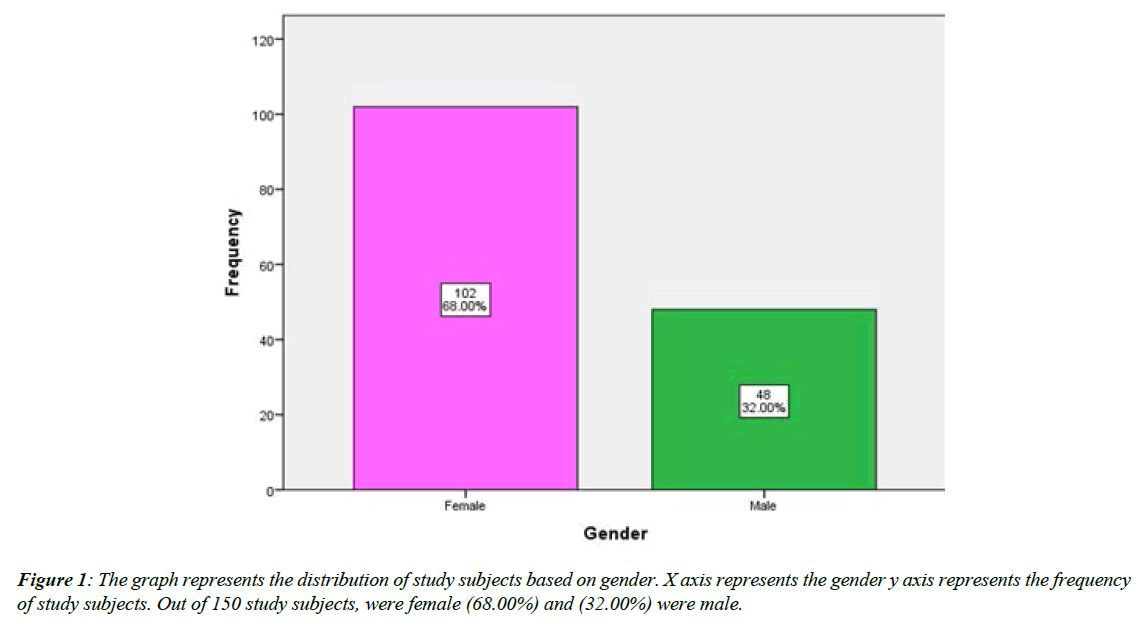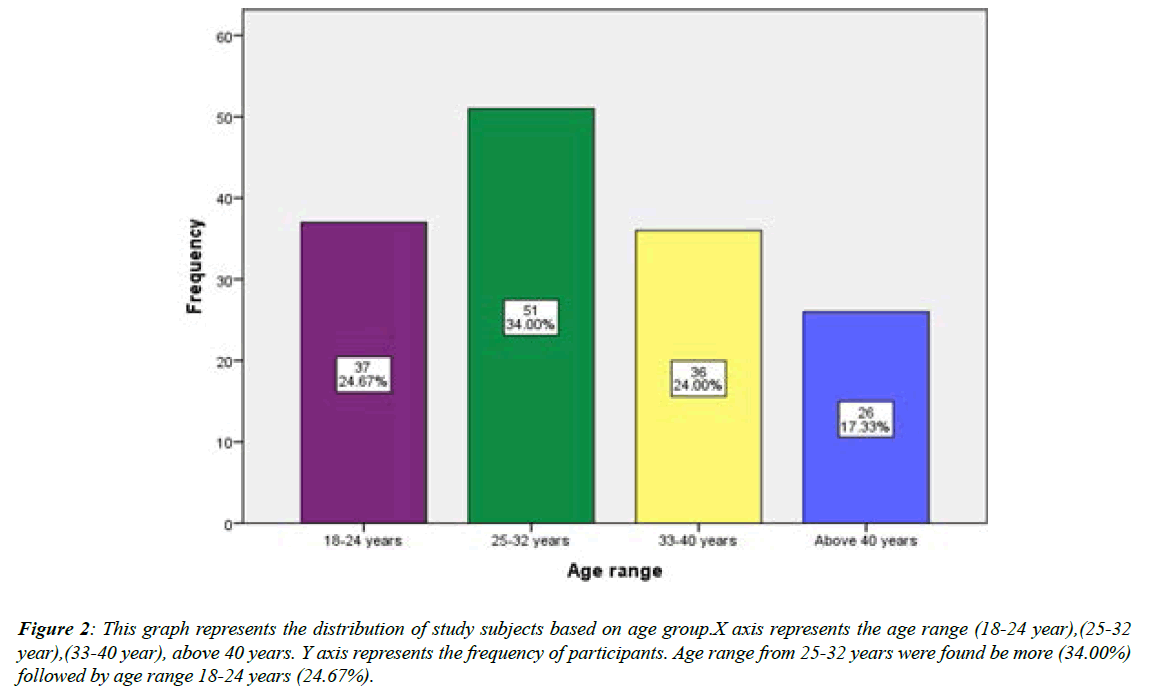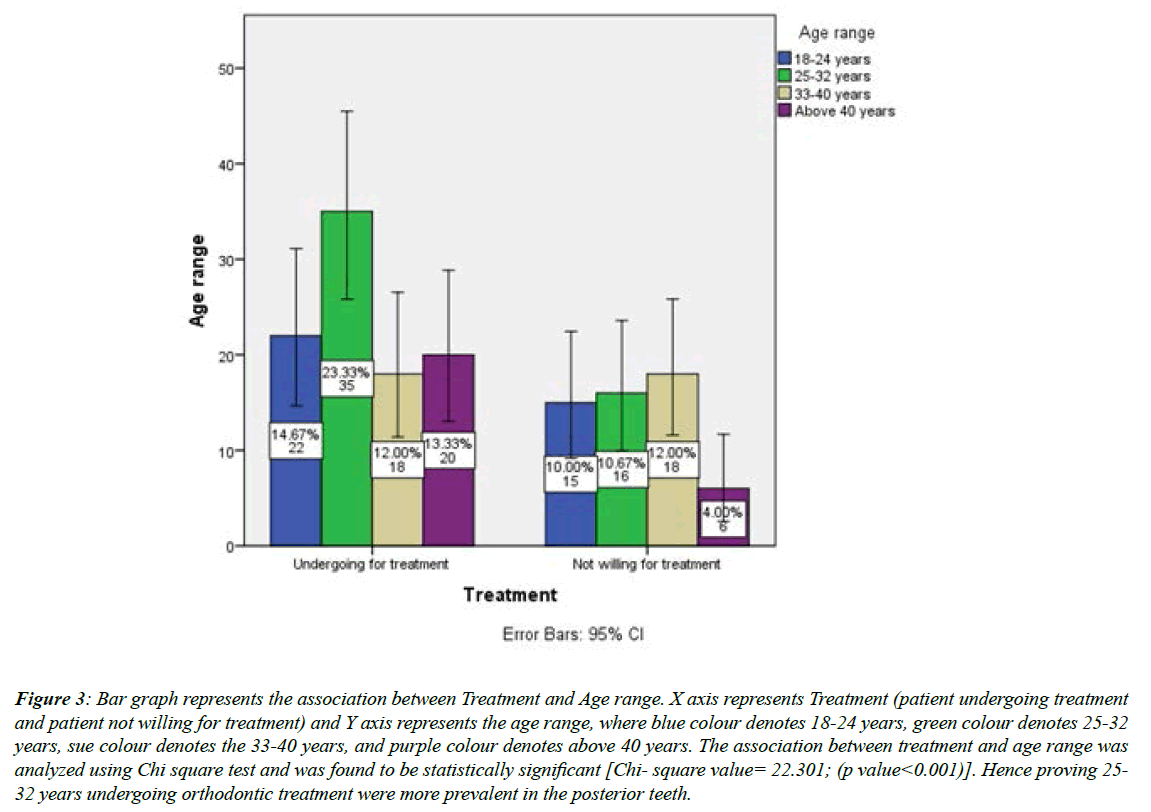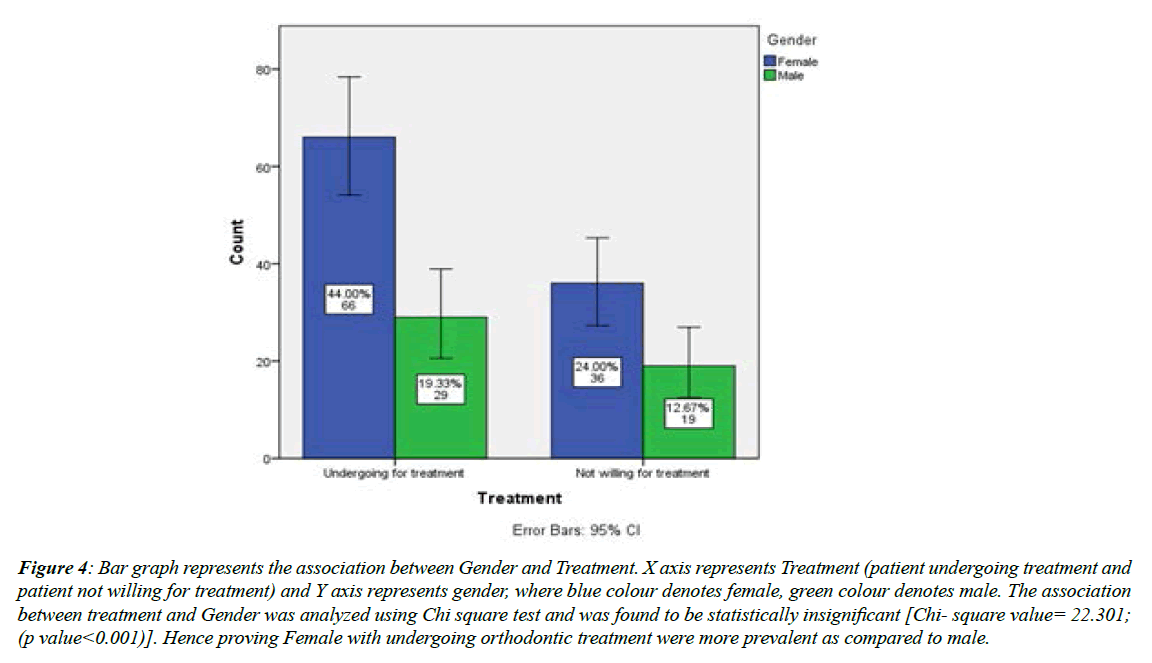Research Article - Journal of Clinical Dentistry and Oral Health (2022) Volume 6, Issue 3
Awareness among patients undergoing treatment for correction of malocclusion VS patients who neglect the treatment.
Amit Singh, Vigneshwar T*Department of Conservative Dentistry and Endodontics, Saveetha Dental College and Hospitals, Saveetha Institute of Medical and Technical Sciences(SIMATS), Saveetha University, Chennai, Tamil Nadu, India
- *Corresponding Author:
- Vigneshwar T
Department of Conservative Dentistry and Endodontics
Saveetha Dental College and Hospitals
Saveetha Institute of Medical and Technical Sciences (SIMATS)
Chennai, Tamil Nadu, India
E-mail: vigneshwart.sdc@saveetha.com
Received: 15-Apr-2022, Manuscript No. AACDOH-22-60873; Editor assigned: 18-Apr-2022, PreQC No. AACDOH-22-60873 (PQ); Reviewed: 02-May-2022, QC No. AACDOH-22-60873; Revised: 05-May-2022, Manuscript No. AACDOH-22-60873 (R); Published: 12-May-2022, DOI:10.35841/aacdoh- 6.3.111
Citation: Singh A, Vigneshwar T. Awareness among patients undergoing treatment for correction of malocclusion VS patients who neglect the treatment. J Clin Dentistry Oral Health 2022;6(3):111
Abstract
Aim: Orthodontics is the branch of dentistry concerned with facial growth, development of the dentition and occlusion together with the prevention and correction of occlusal anomalies. e main indications for orthodontic treatment are to improve oral function, aesthetics and general dental health.e main aims of orthodontic treatment are,therefore, to eliminate functional problems that may predispose a patient to TMD;encourage the eruption and alignment of displaced or impacted teeth; remove any trauma from occlusion and/or displaced teeth and/or improve facial and dental aesthetics by aligning and levelling the teeth, correcting the over jet and overbite to establish a mutually protected occlusion, within a stable so tissue environment. Material and Methods Case sheet of all the patients reporting to the OPD of Saveetha Dental College with malocclusion treatment.The study was conducted between June 2020-March 2021.This university setting study a sample of 150 pateints. Data tabulated with parameters of age, gender and treatment Microsoft excel 2016 (microsoft office 10) was used to collect data and later was imported to SPSS software for statistical analysis. Results: The prevalence of Orthodontic treatment was found to be more in Females (68.00%) than Males (48.00%) Among the age groups of 18-24 years, 25-32 years, 33-40 years, Above 40, it was more prevalent in 25-32 years age group (34.00%) Among the willing of treatment and not willing for treatment among them more patients is willing treatment. The correlation between gender and treatment was found to be insignificant with p> 0.05. Conclusion: Within the limits of the study, the age group of (25-32) years and female patients had a higher prevalence of orthodontic treatment than males. However, no significant statistics were found for the prevalence of age and orthodontic treatment p>0.05 (chi-square test).
Keywords
TMD, Orthodontic treatment, Aesthetic, Impacted teeth.
Introduction
The most common tooth development anomalies were usually maloclusion, which usually manifested itself during childhood as a misalignment of teeth or relationship of dental arches were improper [1]. Many studies believe that malocclusion is a divergence from a normal esthetic appearance rather than a health disorder in the general population [2]. Several studies have evaluated the prevalence of malocclusion in various populations and have reported different prevalence rates (39–98%) [3]. Malocclusion results in numerous issue affected individuals, including facial appearance and low confidence it additionally cause problems related to the masticatory system, the temporomandibular joint disorder, problems with swallowing and speech, susceptibility to facial traumatic injuries and development of caries and periodontal problems [4]. In addition, the individuals with malocclusion will not be satisfied with their facial appearance, resulting in inappropriate social responses and development of emotional and mental problems. In other words, Oral Health-Related Quality of Life is disturbed in a large proportion of affected individuals. Large proportion of dental treatments comprises orthodontic treatments and in most cases they are carried out during adolescence and early adulthood to solve malocclusion problems [5]. The personal satisfaction is characterized as an abstract judgment of a person of his/her wellbeing status and indeed fulfillment or disappointment with explicit parts of life, which are significant for the person [6]. At present, abnormal somatic, psychosomatic and social functioning of individuals are considered as important concern in the evaluation of oral health [7]. Failure of regularly utilized devices to assess and measure oral wellbeing, like assessment of the capacity of patients to bite food and partake in the flavor of food thing has resulted in a new direction and attitude toward evaluation of oral health by new quantification tools such as OHQoL.
The relationship between the quality of life and malocclusion has not been established. However, evidence suggests that evaluations in relation to a need for correction of malocclusion should be patient-oriented or subjective [8]. In other words, the need for orthodontic treatment is related to OHQoL, but it is not necessarily related to objective (clinical) criteria, because clinical criteria reflect the severity of the problem and orthodontic treatment, compared to other dental treatments, is much more greatly under the influence of social and emotional factors. A large number of researchers believe that clinical evaluation alone has serious limitations given the accurate definition of health as something beyond the boundaries of clinical dimensions and social and emotional aspects should be incorporated in it [9]. Therefore, it is necessary that clinical criteria be replaced by OHQoL tools to evaluate patient need for orthodontic treatment. Several studies have evaluated the relationship between malocclusion and the quality of life in relation to oral health, with somewhat contradictory results.
Our team has extensive knowledge and research experience that has translated into high quality publications [10-29]. Therefore the aim of the study is to create awareness about orthodontic treatment and their effect.
Materials and Methods
This record based, descriptive study was conducted among patients reporting to the OP of Saveetha Dental College. Case sheets of all the Patients of OP Department of Saveetha dental colleges were reviewed for a period of ten months [June 2020 and March 2021]. Sample of 150 patients regarding orthodontic treatment were taken.
Prior to the start of the study, ethical approval was obtained from Scientific Review Board, Saveetha Dental College, SIMATS University. Data consisting of age, gender and malocclusion teeth was retrieved from the records of patients who visited dental college from June 2020-March 2021.
The age was grouped into (18-24 years), (25-32 years), (33-40 years), above 40 years. The gender includes male and female. Patient willing for treatment and some patient is not willing for treatment. Data was recorded and tabulated in MS excel. Then the tabulated data expressed by means of frequency and percentage. Chi-square test was employed to find the association between age and anterior/posterior teeth, Gender and malocclusion teeth with level of statistical significance at p<0.05.
Results
The final database consisted of 150 patients of Indian origin in which about 68.00% female patients and 32.00% male patients were included. Among the various age groups included for this study, the age group which had a higher prevalence for undergoing orthodontic treatment was the 25-32 years age group that is about 51 patients (34.00%) following which was 18-24 years age group with 37 patients (24.67%) and 33-40 years with 36 patients (24.00%). Females were predominantly distributed than males in the present study. It was evident from the results female patients had the highest prevalence for malocclusion and compared to male. The association between gender and treatment for malocclusion of the study population was found to be statistically insignificant with p>0.05 (Chi square test) (Figure 1-4).
Figure 2: This graph represents the distribution of study subjects based on age group.X axis represents the age range (18-24 year),(25-32 year),(33-40 year), above 40 years. Y axis represents the frequency of participants. Age range from 25-32 years were found be more (34.00%) followed by age range 18-24 years (24.67%).
Figure 3: Bar graph represents the association between Treatment and Age range. X axis represents Treatment (patient undergoing treatment and patient not willing for treatment) and Y axis represents the age range, where blue colour denotes 18-24 years, green colour denotes 25-32 years, sue colour denotes the 33-40 years, and purple colour denotes above 40 years. The association between treatment and age range was analyzed using Chi square test and was found to be statistically significant [Chi- square value= 22.301; (p value<0.001)]. Hence proving 25- 32 years undergoing orthodontic treatment were more prevalent in the posterior teeth.
Figure 4: Bar graph represents the association between Gender and Treatment. X axis represents Treatment (patient undergoing treatment and patient not willing for treatment) and Y axis represents gender, where blue colour denotes female, green colour denotes male. The association between treatment and Gender was analyzed using Chi square test and was found to be statistically insignificant [Chi- square value= 22.301; (p value<0.001)]. Hence proving Female with undergoing orthodontic treatment were more prevalent as compared to male.
Discussion
The data for this retrospective study was based on residents of Chennai seeking treatment at Saveetha Dental College, Chennai. Currently there are no existing studies investigating the correlation of age with treatment for malocclusion. Since all the data was included without a sorting process, no bias was expected in the selection of patients. The current study is done to compare the gender associated with correction of malocclusion
According to current study, females are more willing for orthodontic treatment as compared to male. Supportive study done by Navabi et al state that females are more conscious of their looks and they are more conscious of their oral hygiene [30]. Another study done by Inglehart et al suggested that females are more periodontal compromised will leads to not getting proper orthodontic treatment [31]. The present study observes that age range 25-32 years age group are more prevalence for undergoing treatment. In a study done by Kim et al. suggested that the middle age group had a relatively high percentage of interest in orthodontic treatment. In addition, the result of this study demonstrated that patients aged over 40 years tend to think that they are too old for orthodontic treatment and that treatment may do more harm than good. These results certainly indicate that more information should be provided to the public that proper orthodontic treatment accompanied with oral and systemic disease control do more good than harm.
Conclusion
Within the limit of this study the rate of positive perception towards orthodontic treatment was 48.5% within the total sampled population. Compared to participants in their 25- 32 years (34%), those in their 40s had a lower percentage of interest in treatment (17.33%). No statistically significant differences were observed between the genders in any of the age groups. Demographic characteristics were not significantly associated with the positive interests.
Acknowledgements
The authors would like to acknowledge the help and support rendered by the Department of Information Technology of Saveetha Dental College and Hospitals.
Funding
The present study was supported by the following agencies, Saveetha Dental College, Saveetha Institute of Medical and Technical Science, Gradient Commercial Pvt LTD.
Conflict Of Interest
Nil
References
- Papadopoulos MA. Orthodontic treatment of the Class II noncompliant patient: current principles and techniques. Elsevier Health Sci. 2006.
- Melsen B. Adult Orthodontics. John Wiley & Sons; 2012;408 .
- Choi SH, Kim JS, Kim CS, et al. The influence of age on lip-line cant in adults: a cross-sectional study. Korean J Orthod. 2016;46(2):81-6.
- Hassan AH, Amin HE-S. Association of orthodontic treatment needs and oral health-related quality of life in young adults. Am J Orthod Dentofacial Orthop. 2010;137(1):42–7.
- Navabi N, Nakhaee N, Mirzadeh A. Validation of a Persian Version of the Oral Health Impact Profile (OHIP-14). Iran J Public Health. 2010;39(4):135–9.
- Burton-Jeangros C, Cullati S, Sacker A, et al. A Life Course Perspective on Health Trajectories and Transitions. Springer. 2015;213.
- Yao J, Li D-D, Yang Y-Q, et al. What are patients’ expectations of orthodontic treatment: a systematic review. BMC Oral Health. 2016 ;16(1):1–8.
- Hassan AH, Hassan MH, Linjawi AI. Association of orthodontic treatment needs and oral health-related quality of life in Saudi children seeking orthodontic treatment. Patient Pref Adh. 2014;8:1571.
- Muthukrishnan L. Imminent antimicrobial bioink deploying cellulose, alginate, EPS and synthetic polymers for 3D bioprinting of tissue constructs. Carbo Poly. 2021;260:117774.
- PradeepKumar AR, Shemesh H, Nivedhitha MS, et al. Diagnosis of vertical root fractures by cone-beam computed tomography in root-filled teeth with confirmation by direct visualization: a systematic review and meta-analysis. J Endo. 2021;47(8):1198-214.
- Chakraborty T, Jamal RF, Battineni G, et al. A review of prolonged post-COVID-19 symptoms and their implications on dental management. Int J Environ Res Public Health. 2021;18(10):5131.
- Muthukrishnan L. Nanotechnology for cleaner leather production: a review. Environ Chem Lett. 2021;19(3):2527-49.
- Teja KV, Ramesh S. Is a filled lateral canal–A sign of superiority?. J Dent Sci. 2020;15(4):562.
- Narendran K, MS N, Sarvanan A. Synthesis, Characterization, Free Radical Scavenging and Cytotoxic Activities of Phenylvilangin, a Substituted Dimer of Embelin. Ind J Pharmac Sci. 2020;82(5):909-12.
- Reddy P, Krithikadatta J, Srinivasan V, et al. Dental caries profile and associated risk factors among adolescent school children in an urban South-Indian city. Oral Health Prev Dent. 2020;18(1):379-86.
- Sawant K, Pawar AM, Banga KS, et al. Dentinal Microcracks after Root Canal Instrumentation Using Instruments Manufactured with Different NiTi Alloys and the SAF System: A Systematic Review. App Sci. 2021;11(11):4984.
- Bhavikatti SK, Karobari MI, Zainuddin SL, et al. Investigating the Antioxidant and Cytocompatibility of Mimusops elengi Linn Extract over Human Gingival Fibroblast Cells. Int J Enviro Res Public Hea. 2021;18(13):7162.
- Karobari MI, Basheer SN, Sayed FR, et al. An In Vitro Stereomicroscopic Evaluation of Bioactivity between Neo MTA Plus, Pro Root MTA, BIODENTINE & Glass Ionomer Cement Using Dye Penetration Method. Mat. 2021;14(12):3159.
- Rohit Singh T, Ezhilarasan D. Ethanolic extract of Lagerstroemia Speciosa (L.) Pers., induces apoptosis and cell cycle arrest in HepG2 cells. Nutr Cancer. 2020;72(1):146-56.
- Ezhilarasan D. MicroRNA interplay between hepatic stellate cell quiescence and activation. Euro J Pharmacol. 2020;885:173507.
- Romera A, Peredpaya S, Shparyk Y, et al. Bevacizumab biosimilar BEVZ92 versus reference bevacizumab in combination with FOLFOX or FOLFIRI as first-line treatment for metastatic colorectal cancer: a multicentre, open-label, randomised controlled trial. Lancet Gastroenterol Hepatol. 2018;3(12):845-55.
- Raj R K. β‐Sitosterol‐assisted silver nanoparticles activates Nrf2 and triggers mitochondrial apoptosis via oxidative stress in human hepatocellular cancer cell line. J Biomed Mat Res Part A. 2020;108(9):1899-908.
- Vijayashree Priyadharsini J. In silico validation of the non‐antibiotic drugs acetaminophen and ibuprofen as antibacterial agents against red complex pathogens. J Periodontol. 2019;90(12):1441-8.
- Priyadharsini JV, Girija AS, Paramasivam A. In silico analysis of virulence genes in an emerging dental pathogen A. baumannii and related species. Archiv Oral Biol. 2018;94:93-8.
- Uma Maheswari TN, Nivedhitha MS, Ramani P. Expression profile of salivary micro RNA-21 and 31 in oral potentially malignant disorders. Braz Oral Res. 2020;34.
- Gudipaneni RK, Alam MK, Patil SR, et al. Measurement of the maximum occlusal bite force and its relation to the caries spectrum of first permanent molars in early permanent dentition. J Clini Pediatr Dent. 2020;44(6):423-8.
- Chaturvedula BB, Muthukrishnan A, Bhuvaraghan A, et al. Dens invaginatus: a review and orthodontic implications. Br Dent J. 2021;230(6):345-50.
- Kanniah P, Radhamani J, Chelliah P, et al. Green synthesis of multifaceted silver nanoparticles using the flower extract of Aerva lanata and evaluation of its biological and environmental applications. Chem Select. 2020;5(7):2322-31.
- Navabi N, Farnudi H, Rafiei H, et al. Orthodontic Treatment and the Oral Health-Related Quality of Life of Patients. J Dent. 2012;9(3):247.
- Inglehart MR, Bagramian R. Oral Health-related Quality of Life. Quintessence Publ Com. 2002;208.
- Kim Y. Study on the perception of orthodontic treatment according to age: A questionnaire survey. Korean J Orthod. 2017;47(4):215.
Indexed at, Google Scholar, Cross Ref
Indexed at, Google Scholar, Cross Ref
Indexed at, Google Scholar, Cross Ref
Indexed at, Google Scholar, Cross Ref
Indexed at, Google Scholar, Cross Ref
Indexed at, Google Scholar, Cross Ref
Indexed at, Google Scholar, Cross Ref
Indexed at, Google Scholar, Cross Ref
Indexed at, Google Scholar, Cross Ref
Indexed at, Google Scholar, Cross Ref
Indexed at, Google Scholar, Cross Ref
Indexed at, Google Scholar, Cross Ref
Indexed at, Google Scholar, Cross Ref
Indexed at, Google Scholar, Cross Ref
Indexed at, Google Scholar, Cross Ref
Indexed at, Google Scholar, Cross Ref
Indexed at,Google Scholar, Cross Ref
Indexed at, Google Scholar, Cross Ref



